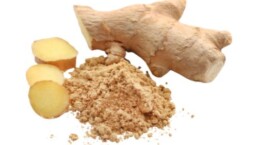Ginger Powder
- Botanical Name: Zingiber officinale
- Family: Zingiberaceae
- Description: Ginger is a flowering plant with underground rhizomes (roots) that are widely used as a spice and in traditional medicine. The plant has green stems with narrow leaves and produces clusters of white or yellow flowers.
- Culinary Uses:
- Spice: Ginger is a versatile spice used in various cuisines worldwide. It adds a distinctive flavor to both sweet and savory dishes.
- Teas and Infusions: Ginger is commonly used to make teas and infusions, providing a warming and comforting beverage.
- Medicinal Uses:
- Digestive Aid: Ginger has a long history of use as a digestive aid, helping to alleviate nausea, indigestion, and bloating.
- Anti-Inflammatory: It possesses anti-inflammatory properties and is used to reduce inflammation and pain.
- Cold and Flu Relief: Ginger is often used to relieve symptoms of colds and flu, as it may help alleviate congestion and soothe a sore throat.
- Menstrual Discomfort: Some women use ginger to ease menstrual discomfort and reduce menstrual pain.
- Traditional Medicine:
- Ayurveda: In traditional Indian medicine (Ayurveda), ginger is used to balance the doshas and treat various ailments.
- Traditional Chinese Medicine (TCM): TCM incorporates ginger for its warming properties and to address conditions related to cold and dampness.
- Culinary and Non-Culinary Products:
- Condiments: Ground or fresh ginger is used in making sauces, marinades, and condiments.
- Beverages: Ginger is used in the production of ginger ale, ginger beer, and various non-alcoholic beverages.
- Anti-Inflammatory Properties:
- Ginger contains bioactive compounds like gingerol, which have potent anti-inflammatory effects, potentially helpful for conditions like osteoarthritis.
- Nausea Relief:
- Ginger is renowned for its ability to reduce nausea, making it a natural remedy for morning sickness during pregnancy and nausea induced by chemotherapy.
- Digestive Health:
- It aids digestion by promoting the release of digestive enzymes, preventing indigestion and discomfort.
- Immune System Support:
- The antioxidant and anti-inflammatory properties of ginger may contribute to overall immune system support.
- Pain Relief:
- Ginger has analgesic properties and may help alleviate various types of pain, including menstrual pain and muscle soreness.
- Cardiovascular Health:
- Some studies suggest that ginger may contribute to heart health by reducing blood pressure and improving cholesterol levels.
- Antimicrobial Properties:
- Ginger has demonstrated antimicrobial activity, which may help fight infections.
- Weight Management:
- Ginger may aid in weight management by promoting a feeling of fullness and boosting metabolism.
20 Feet
18 MT
40 Feet
26 MT
Ginger is widely cultivated in tropical and subtropical regions, with top producers including India, China, Nigeria, Indonesia, and Thailand. Its availability is seasonal, with harvesting typically taking place once a year, but variations exist depending on the region.
- Fresh Ginger:
- Harvested rhizomes with a tan outer skin and yellowish flesh.
- Dried Ginger:
- Fresh ginger is dried to enhance shelf life and concentrated flavor.
- Powdered Ginger:
- Dried ginger is ground into a fine powder, convenient for culinary and medicinal uses.
- Ginger Oil:
- Extracted from the ginger rhizome, used in aromatherapy and as a flavoring agent.
- Ginger Extracts:
- Concentrated liquid or solid forms used in various products like supplements and cosmetics.
Packing:
- Fresh Ginger: Packed in mesh or ventilated bags to allow air circulation, preventing mold and decay.
- Dried Ginger: Typically packed in jute bags, cartons, or vacuum-sealed packages.
- Powdered Ginger: Packaged in airtight containers or vacuum-sealed bags to maintain freshness.
- Ginger Oil: Bottled in dark glass to protect from light, and packaging varies based on the intended use.
- Harvesting:
- Ginger is harvested when the plant reaches maturity, usually around 8-10 months.
- Cleaning:
- Fresh ginger is cleaned to remove soil and debris.
- Drying:
- Fresh ginger is sun-dried or dried using commercial drying methods.
- Processing:
- Dried ginger may be further processed into powder, oil, or extracts.
- Quality Control:
- Stringent quality checks ensure compliance with export standards
- Quality Assurance:
- Aalisha Overseas adheres to stringent quality control measures to ensure premium-grade ginger for export.
- Wide Range of Products:
- Offers a diverse range of ginger products, including fresh, dried, powdered, and extracts, catering to various industry needs.
- Compliance with International Standards:
- Aalisha Overseas complies with international food safety and quality standards, ensuring products meet the requirements of importing countries.
- Timely Delivery:
- The company is committed to timely delivery schedules, ensuring customer satisfaction
- Certifications:
- Check for certifications such as ISO, HACCP, and organic certifications, ensuring adherence to international standards.
- Reputation:
- Evaluate the exporter’s reputation in the industry through reviews, testimonials, and references.
- Quality Control Practices:
- Inquire about the exporter’s quality control measures throughout the production and export process.
- Documentation and Compliance:
- A genuine exporter should be well-versed in export documentation and comply with the regulations of both the exporting and importing countries.
- Communication:
- Clear and transparent communication is crucial. A reliable exporter should be responsive to inquiries and provide detailed information about their products and processes.
- Experience:
- Consider exporters with a proven track record and experience in the ginger export industry.

